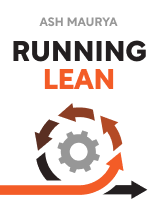

This article is an excerpt from the Shortform book guide to "Running Lean" by Ash Maurya. Shortform has the world's best summaries and analyses of books you should be reading.
Like this article? Sign up for a free trial here.
Why do so many business models fail? What is a Lean Canvas, and how do you create one? How can you better understand your target customers’ problems?
In Running Lean, Ash Maurya shows how you can avoid business failure with the Lean Canvas model. This approach helps build and sustain a flexible business model that evolves alongside customer preferences.
This article will detail how Ash Maurya’s Lean Canvas approach can help businesses avoid failure and move forward with confidence.
Overview of Running Lean
Why do so many business models fail? According to entrepreneur, Lean Canvas creator, and best-selling author Ash Maurya, it’s because entrepreneurs assume they already know what customers want and finalize their plans before testing their ideas. As a result, they create rigid plans that they can’t easily adapt to customers’ actual preferences.
In Running Lean, Ash Maurya suggests that you can avoid this pitfall by adopting continuous validation and iteration. This approach helps build and sustain a flexible business model that evolves alongside customer preferences.
(Shortform note: Why is it important to create a flexible business model? According to business experts, the average lifespan of successful business models—that is, the period during which they effectively cater to market needs—has fallen to less than five years. Therefore, to achieve a sustainable competitive advantage and meet evolving customer expectations, businesses must continually evaluate and redesign their business models.)
Articulate Your Hypotheses and Draft Your Business Model
The first step toward drafting a successful business model is to articulate your hypothesis regarding the factors that will drive its success. During this step, Maurya uses terms like “hypotheses” or “assumptions” to emphasize that your ideas are educated guesses that require validation through research, experimentation, and real-world feedback. He recommends using a Lean Canvas—a condensed, one-page framework that encompasses nine essential elements of a business model, which we’ll explore later in this section—to structure and visualize your hypotheses.
(Shortform note: Maurya adapted this framework from the Business Model Canvas by Alexander Osterwalder and Yves Pigneur, authors of Business Model Generation. The Business Model Canvas offers a comprehensive framework tailored for established businesses seeking to assess existing strategies, analyze competitors, or design new ventures. In contrast, the Lean Canvas is crafted for startups, concentrating on pivotal business aspects like problem-solution fit and competitive edge. This focus makes it a versatile tool for rapidly testing and refining new business ideas.)
Why use a Lean Canvas in place of a traditional business plan? In Running Lean, Ash Maurya explains how traditional business plans are lengthy. As such, they require time-consuming revisions that can hinder your ability to capture and act on market insights—resulting in the business model becoming quickly outdated. In contrast, a Lean Canvas provides a more agile alternative that not only saves time but also encourages an iterative process. By condensing your ideas into a single page, you can swiftly communicate, validate, and update your business model to incorporate new insights and quickly respond to market feedback.
Advice on Drafting Your Lean Canvas
In Running Lean, Ash Maurya suggests three key pieces of advice for drafting your Lean Canvas:
1) Start by filling out the elements that you understand best. Initially focusing on what you know well provides a strong cornerstone upon which to shape your ideas. (Shortform note: Research suggests that starting with what you know works as a catalyst for innovation. By initially addressing familiar elements, you’re more likely to make progress, enhance your confidence, and generate positive momentum that pushes you to explore the more complex or unknown elements of your business model.)
2) Keep your hypotheses brief and straightforward. Concise statements serve as guiding principles that help maintain focus as you iterate and refine your business model. (Shortform note: Concise hypotheses require a delicate balance between conveying essential information and maintaining brevity. If you struggle with this balance, apply the “So what?” test: For every piece of information you’re tempted to add, ask yourself: “Does this significantly enhance understanding of the statement?” If the answer isn’t a resounding “yes,” omit it. Additionally, consider creating a secondary document to capture additional points you want to remember.)
3) Create a separate Lean Canvas for every customer group you identify, as each will likely have unique requirements that influence various elements of your business model. This approach encourages you to explore multiple possibilities rather than fixating on a single implementation of your idea—which, in turn, increases your chances of developing a profitable business model.
The Nine Essential Business Model Elements
In Running Lean, Ash Maurya explains why your Lean Canvas should include the following nine elements: customer groups, customer problems, possible solutions, value offer, touchpoints, profit sources, expenses, key performance indicators, and competitive edge. Let’s explore each element in detail.
Element 1: Customer Groups
Hypothesize the customer groups that will want your product. Maurya suggests that you narrow your selection of customer groups by distinguishing between paying customers and non-paying customers and then focusing on early adopters rather than mainstream users. (Recall: If different customer groups have distinct needs influencing other aspects of your business model, you should create separate Lean Canvases for each group.)
Element 2: Customer Problems
Hypothesize the top three customer problems to address that will attract and satisfy your target customer group. Maurya recommends that you list the existing alternatives customers use to address those problems and identify the issues they encounter while using these alternatives.
Element 3: Possible Solutions
Hypothesize the solutions that will effectively address your target customer group’s problems. In Running Lean, Ash Maurya says that you should focus on the simplest thing that effectively addresses the problem.
Element 4: Value Offer
Hypothesize how your solution offers unique value and why it will resonate with your target customer group. Maurya points out that you should explicitly connect your offer’s value to the primary problem you aim to solve for your customers.
Element 5: Touchpoints
Hypothesize the communication and delivery touchpoints through which you’ll interact with your customers and provide your products or services. In Running Lean, Ash Maurya suggests that you identify touchpoints that can handle increased demand and accommodate future growth so that you can start building and testing them alongside your offer.
Element 6: Profit Sources
Hypothesize how you intend to generate a profit and the prices that your target customer groups will pay. Maurya emphasizes the importance of setting prices early on, as it influences the customer groups you’ll attract.
Element 7: Expenses
Hypothesize the expenses associated with operating your business model. Maurya advises that you consider both short-term and long-term expenses.
Element 8: Key Performance Indicators
Hypothesize three to five key metrics that will help you measure the progress and success of your business model. Maurya suggests that you prioritize outcome metrics over output metrics for a more accurate evaluation. Outcome metrics gauge the results you achieve, measuring the actual outcomes of your efforts. In contrast, output metrics focus on the actions you take without capturing the tangible results of those actions.
Element 9: Competitive Edge
Hypothesize the features and benefits that will set your offer apart from the competition. In Running Lean, Ash Maurya suggests that you focus on why your offer is difficult for competitors to replicate. He explains that while competitors will always attempt to mimic successful products or services, you can gain a competitive edge by leveraging the power of intangible factors. These factors, such as a specialized team’s expertise or a customer-focused approach, contribute to your offer’s unique appeal, making it challenging for competitors to imitate.
Test Your Hypotheses and Refine Your Business Model
Now that you’ve created one—or several—Lean Canvases, let’s focus on testing your hypotheses to validate their viability and ensure a solid foundation for your business.
In this part of the guide, we’ll explore Maurya’s four testing stages for validating and refining your hypotheses, along with specific objectives to focus on during each stage:
- Investigate the problems.
- Validate the solution.
- Run pilot tests.
- Launch and optimize.
Let’s explore each of these stages.
Test Stage #1: Investigate the Problems
During the first stage of testing, your objective is to thoroughly understand your target customer group’s problems to determine whether you’re developing an offer that addresses their genuine needs.
Maurya suggests that you complete this testing stage by conducting customer interviews, focusing on the following four areas:
1) What Specific Problems They Encounter
In Running Lean, Ash Maurya says that researching what specific problems customers encounter helps clarify whether your initial hypothesis regarding customer problems was correct, or if there are more promising problems to address. It prevents you from investing resources in a solution that’s ultimately not what customers need.
2) Who Is Experiencing the Problems
Maurya suggests that identifying who experiences the problems will provide valuable insights into the demographics of your early adopters. This, in turn, helps you refine your target market and tailor a solution that aligns with their needs.
3) How They’re Currently Addressing Their Problems
According to Maurya, investigating how customers currently address their problems increases your awareness of existing alternatives in the market (potential competition), and helps you identify opportunities for differentiation.
4) Their Level of Satisfaction With These Existing Alternatives
Maurya explains that exploring customer satisfaction levels with existing alternatives helps you assess the pros and cons of competitive products. This, in turn, opens up opportunities for developing a more effective solution.
5) Update Your Lean Canvas
Once you’ve completed your interviews and gained a comprehensive understanding of your target customer group’s problems, update all relevant elements on your Lean Canvas. Note that, due to their interdependent nature, changes to one element will inevitably influence the others. For example, changing the problem you’ll address will likely impact your solution, your offer, your competitive edge, and your expenses. Therefore, remember to update all elements of your Lean Canvas throughout the four testing stages.
Before moving on to the next test stage, Maurya suggests that you determine whether the identified problems can be solved—consider the feasibility of potential solutions to ensure that pursuing them is viable for your business.
Test Stage #2: Validate the Solution
Once you’ve identified the problem to address and have updated your potential solution, your next objective is to validate this solution with your early adopters. Maurya explains that this validation process ensures that your offer effectively solves your customer group’s problems while aligning with their preferences—which, in turn, guarantees demand for your product or service.
He suggests the following four-step process for validating your solution:
1) Create a Prototype
Maurya suggests that you create a prototype that showcases your solution’s features to help early adopters visualize its functionality. For example, to help early adopters grasp how your productivity app would work, create an interactive video or wireframes to demonstrate its user interface.
2) Present Your Prototype to Early Adopters
Next, Maurya recommends that you present your prototype to early adopters and gather feedback. This feedback should include their overall impression of your solution, its effectiveness in addressing their problems, and their willingness to pay the price you set for it.
3) Refine Your Solution and Pricing Model
Refine your solution and pricing model to accommodate the feedback you receive. Maurya advises that you repeat the first two steps until you feel confident that your solution includes the essential features your early adopters want, and that your pricing aligns with their expectations and willingness to pay.
4) Obtain Commitments From Your Early Adopters
Maurya suggests that you obtain commitments from your early adopters to confirm market demand for your offer. These commitments can take the form of pre-orders, signed letters of intent, or agreements to participate in beta testing.
Test Stage #3: Run Pilot Tests
By this point, you’ve determined the essential features to include in an initial version of your offer, set the price, and generated demand among your early adopters. Now, your objective is to run pilot tests for your offer. This involves building and releasing the first version of your offer and making iterative improvements based on feedback loops with your early adopters. Maurya explains that this approach ensures that your offer aligns with the expectations of your early adopters, setting the stage for a successful launch to a larger customer base.
He suggests the following five-step process for running pilot tests and improving your offer:
1) Develop a version of your offer that includes the essential features identified during the solution validation stage.
2) Release the offer to your early adopters and gather their feedback. Additionally, identify any limitations in your business model that might hinder customer adoption, such as limited payment options or other usability issues.
3) Analyze the feedback received and identify ways to improve the overall viability of your offer. This may involve incorporating sought-after features, resolving usability issues, refining your sales process, or addressing specific concerns raised by your early adopters.
4) Improve your offer based on the feedback and insights gathered. Repeat steps two and three, releasing updated versions of your offer and gathering feedback iteratively until you believe your offer is ready to market to a larger customer base.
5) Request testimonials from satisfied early adopters to help build credibility and trust with potential customers.
Test Stage #4: Launch and Optimize
Up until now, we’ve focused on aligning your product or service with what customers want. Now that you’re ready to launch your product to a larger customer base, your next objective is to make constant improvements to the way you operate so that you can optimize your business model for growth. Maurya emphasizes the importance of conducting regular short-term tests to achieve this optimization. These tests serve as checkpoints to efficiently identify and address weaknesses, allowing you to continually refine your strategies for long-term sustainability and profitability.
He suggests the following five-step process for conducting short-term tests:
1) Launch your product and monitor your key performance indicators to identify areas of weakness that hinder your growth. Pinpoint one specific weakness that significantly impacts your growth trajectory. For example, you may discover that your payment system is the weakest area, leading to a high percentage of customer abandonment during check-out.
2) Identify the factors that might contribute to this weakness. For example, for your productivity app, potential factors could include a complicated user interface, limited payment options, or slow transaction processing.
3) Generate multiple solutions to address the weakness. Explore various approaches and focus on finding the simplest yet most effective solution. For example, you might implement a more intuitive user interface, integrate additional payment gateways, or optimize the transaction processing speed.
4) Implement a single solution for a defined period of time and test its effectiveness in addressing the weakness. Focus on obtaining quick feedback and insights. For example, you could conduct A/B tests by offering different versions of the payment system to different segments of your user base. 5) Review the outcomes of the test and evaluate whether the implemented solution successfully resolves the weakness or if further refinement is required. Use the insights gained to iterate and improve your approach, ensuring continuous progress toward optimization.

———End of Preview———
Like what you just read? Read the rest of the world's best book summary and analysis of Ash Maurya's "Running Lean" at Shortform.
Here's what you'll find in our full Running Lean summary:
- The reason why so many business models fail
- Why you should never assume you know what your customers want
- Why your business should be built on continuous validation and iteration






